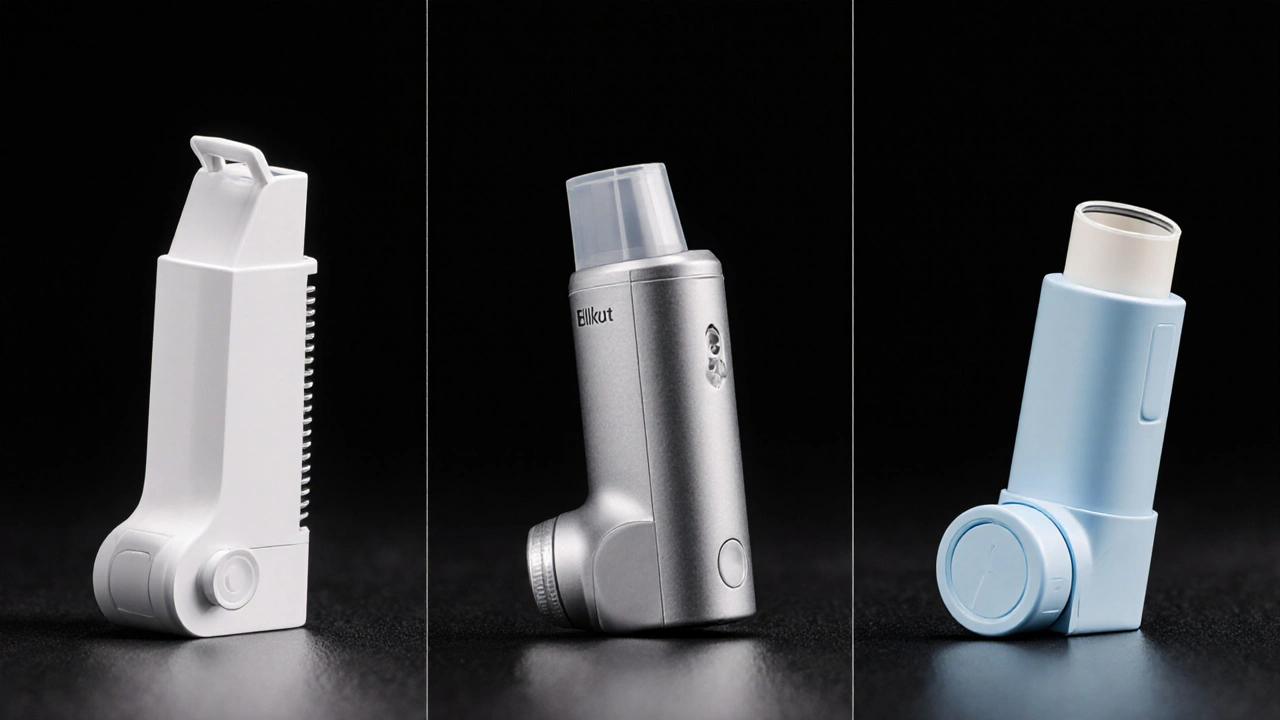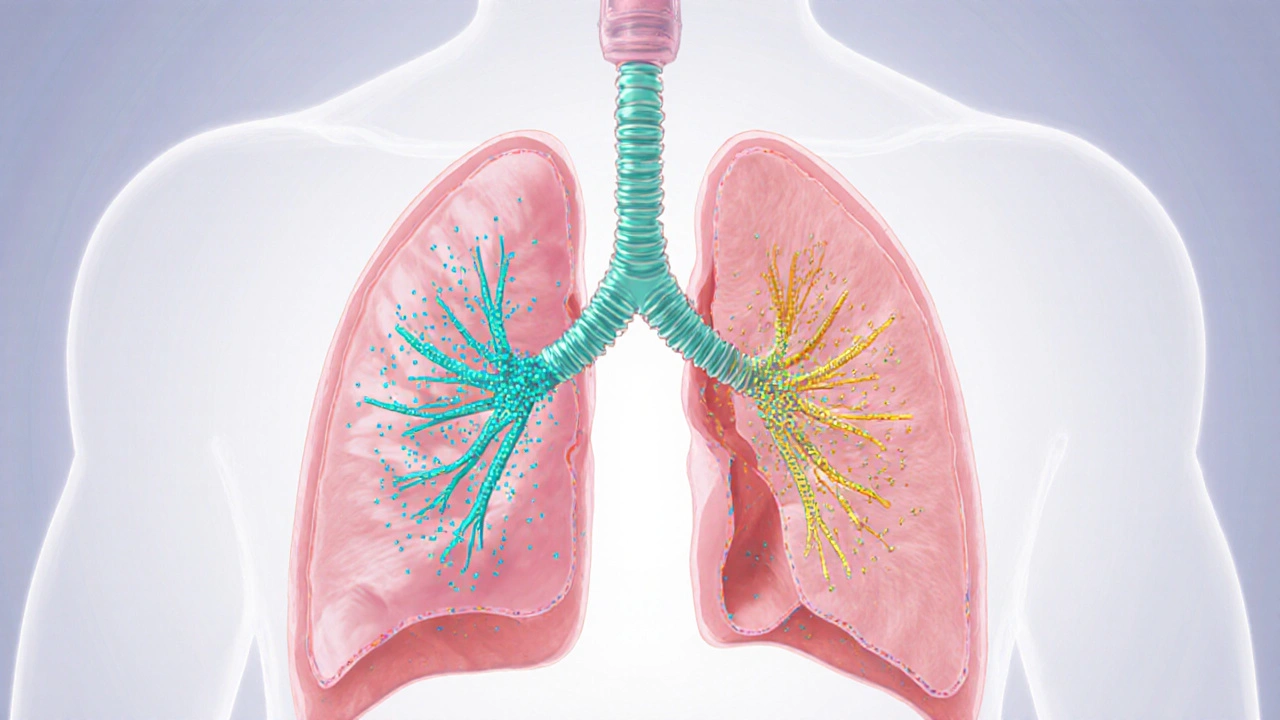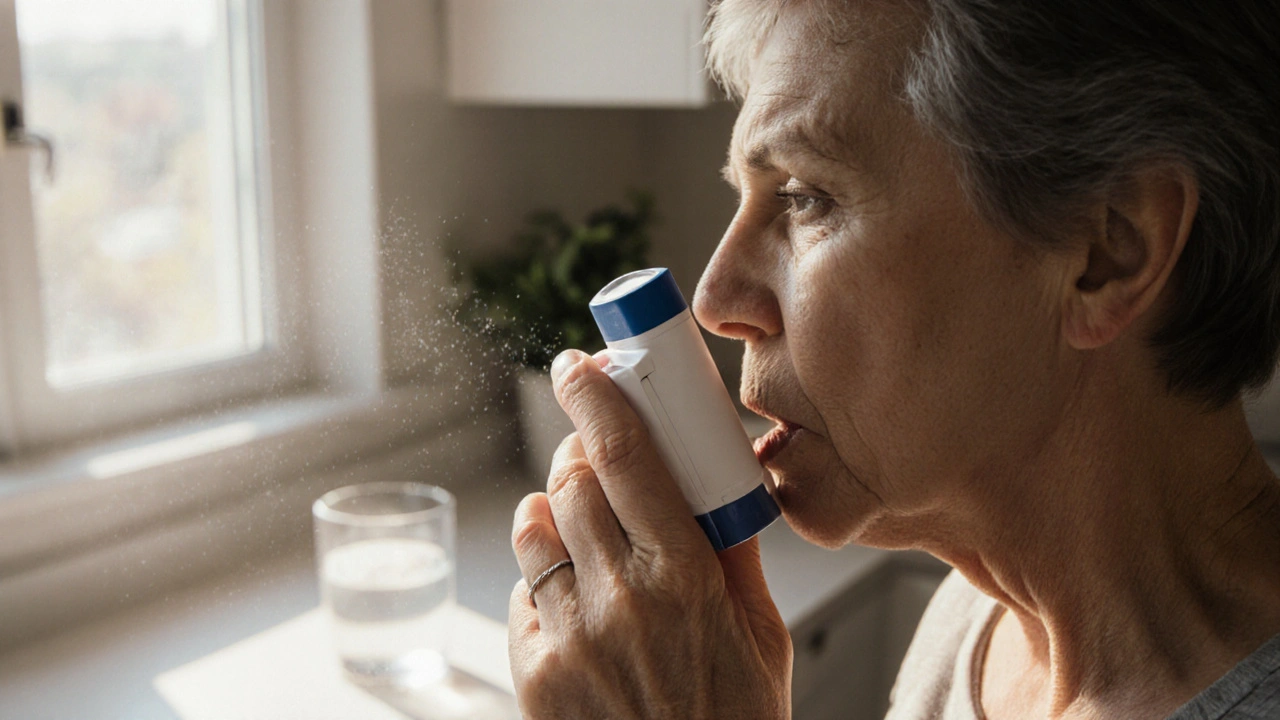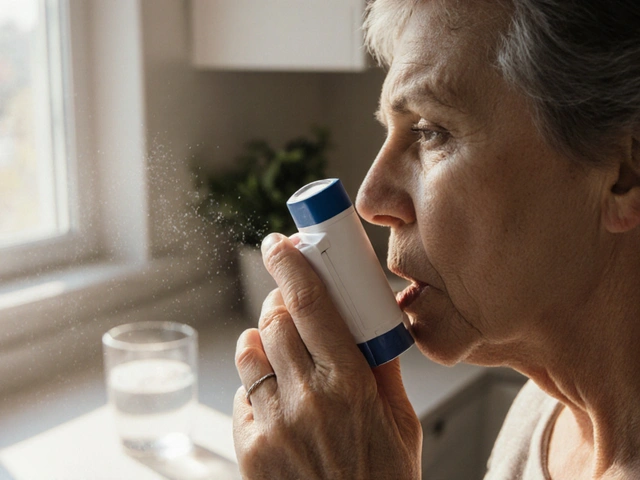Inhaler Comparison Tool
Select your preferred inhaler to compare key features:
| Feature | Selected Inhaler |
|---|---|
| Device Type | - |
| LABA Component | - |
| ICS Component | - |
| Doses Per Cartridge | - |
| Onset of Bronchodilation | - |
| Typical Cost (AU$) | - |
When you’re juggling asthma or COPD, the inhaler you choose can feel like a life‑or‑death decision. Symbicort Turbuhaler often lands on the shortlist because it bundles a fast‑acting bronchodilator with a corticosteroid, but dozens of other devices claim similar benefits. Below you’ll get a straight‑up look at how Symbicort stacks up against the most common competitors, what each option actually does in the lungs, and which one fits different lifestyles and budgets.
What Exactly Is Symbicort Turbuhaler 60MD?
Symbicort Turbuhaler 60MD is a dry‑powder inhaler (DPI) that delivers 12µg of formoterol and 200µg of budesonide per inhalation. The device uses a high‑velocity airflow to disperse the powder, so you don’t need a propellant or a spacer. Formoterol is a long‑acting β2‑agonist (LABA) that relaxes airway muscles within minutes and keeps them open for up to 12hours. Budesonide is an inhaled corticosteroid (ICS) that reduces airway inflammation over days to weeks. The 60‑dose cartridge is designed for twice‑daily use, giving a total of 30days of therapy.
Key Traits to Compare
- Device type: Turbuhaler (DPI)
- Active ingredients: Formoterol (LABA) + Budesonide (ICS)
- Dose frequency: Twice daily
- Approved for: Asthma (step3‑5) and COPD
- Typical cost (Australia, 2025): AU$45-55 for a 60‑dose cartridge
Major Alternatives on the Market
Below are the inhalers most often pitched as substitutes. Each one pairs a LABA with an ICS, but the exact molecules, device mechanics, and dosing schedules differ.
Advair Diskus combines salmeterol (LABA) and fluticasone propionate (ICS) in a breath‑actuated Diskus device. It’s available in 60‑dose cartridges for twice‑daily use.
Breo Ellipta pairs vilanterol (LABA) with fluticasone furoate (ICS). The Ellipta is a pre‑loaded, ready‑to‑press inhaler delivering one dose per click.
Pulmicort Turbuhaler contains only budesonide (ICS) and is used as a maintenance‑only inhaler. It’s a DPI like Symbicort but lacks a LABA component.
Seretide Diskus is the European branding for the same salmeterol‑fluticasone combo found in Advair, delivered via a Diskus device.
Relvar Ellipta mirrors Breo’s formulation (vilanterol+fluticasone furoate) but is marketed for COPD in Australia.
Side‑by‑Side Comparison Table
| Attribute | Symbicort Turbuhaler | Advair Diskus | Breo Ellipta | Pulmicort Turbuhaler | Seretide Diskus |
|---|---|---|---|---|---|
| LABA | Formoterol (12µg) | Salmeterol (50µg) | Vilanterol (25µg) | None | Salmeterol (50µg) |
| ICS | Budesonide (200µg) | Fluticasone propionate (250µg) | Fluticasone furoate (100µg) | Budesonide (200µg) | Fluticasone propionate (250µg) |
| Device type | Turbuhaler (DPI) | Diskus (DPI) | Ellipta (pre‑loaded DPI) | Turbuhaler (DPI) | Diskus (DPI) |
| Doses per cartridge | 60 (2× daily) | 60 (2× daily) | 30 (once daily) | 120 (once or twice daily) | 60 (2× daily) |
| Onset of bronchodilation | ≈5min | ≈5min | ≈5min | N/A (no LABA) | ≈5min |
| Typical Australian price (2025) | AU$45‑55 | AU$50‑60 | AU$55‑65 | AU$30‑40 | AU$50‑60 |

Who Benefits Most from Each Option?
Symbicort Turbuhaler shines for patients who prefer a compact, propellant‑free device and need a rapid‑acting LABA. The twice‑daily schedule works well for people whose symptoms flare up in the morning and evening.
Advair Diskus and Seretide Diskus are similar in performance but rely on salmeterol, which has a slightly slower onset than formoterol. They’re a solid choice if you’re already comfortable with the Diskus mechanism.
Breo Ellipta (and its COPD‑focused twin, Relvar) offer once‑daily dosing, perfect for those who struggle with twice‑daily compliance. The higher‑potency fluticasone furoate means you can often use a lower total steroid dose.
Pulmicort Turbuhaler is for patients who only need an anti‑inflammatory steroid without a LABA - for example, mild asthma maintained with low‑dose budesonide alone.
How to Pick the Right Inhaler for You
- Check your prescription tier. Some insurers cover DPIs but not certain brand‑name devices. Knowing your Benefit Tier can save $20‑$30 per month.
- Match the dosing schedule to your routine. If you forget afternoon doses, a once‑daily Ellipta may improve adherence.
- Consider the inhaler mechanics. Turbuhalers need a strong, fast inhalation; Diskus devices are breath‑actuated and work well for patients with weaker inspiratory flow.
- Review side‑effect profiles. Formoterol and salmeterol share similar cardiovascular warnings, while fluticasone furoate may carry a slightly higher risk of oral thrush.
- Factor in cost. Generic budesonide inhalers (like Pulmicort) are cheaper, but you’ll need a separate rescue bronchodilator such as salbutamol.
Practical Tips for Using a Turbuhaler
- Exhale fully away from the device - never into the mouthpiece.
- Seal your lips tightly around the mouthpiece, then inhale sharply and deeply.
- Hold your breath for 10seconds before breathing out.
- Wipe the mouthpiece with a dry cloth weekly to prevent powder clumping.
- Store the inhaler at room temperature, away from humidity.
Common Questions & Answers
Frequently Asked Questions
Can I switch from Symbicort Turbuhaler to a Diskus device?
Yes, but you’ll need a new prescription because the active ingredients differ (formoterol+budesonide vs. salmeterol+fluticasone). Your doctor will decide if the change fits your asthma control level.
Is Symbicort safe for COPD patients?
It’s approved for COPD maintenance therapy in Australia. The combination reduces exacerbations, but patients with heart rhythm issues should discuss the LABA component with their cardiologist.
What should I do if I miss a dose?
Take it as soon as you remember, unless it’s almost time for your next scheduled dose. In that case, skip the missed one - don’t double‑dose.
How long does a 60‑dose cartridge actually last?
At the recommended two puffs per day, a 60‑dose cartridge provides 30days of therapy. Many patients keep a spare in case of travel.
Do I need a spacer with Symbicort Turbuhaler?
No. Turbuhalers are designed for direct inhalation, and a spacer can actually reduce powder dispersion.

Bottom Line
If you value a rapid‑acting LABA, a compact DPI, and a twice‑daily routine that aligns with morning/evening symptom peaks, Symbicort Turbuhaler 60MD is a strong contender. For once‑daily simplicity, Breo Ellipta wins. If cost is the biggest driver, Pulmicort (budesonide‑only) or a generic formoterol‑budesonide combo, when available, may shave off dollars.
Talk to your respiratory specialist, weigh the device mechanics, dosing schedule, and out‑of‑pocket price - then stick with the inhaler that feels natural in your hand and keeps your lungs clear.





Christopher Xompero
September 30, 2025 AT 20:13Wow, this whole inhaler showdown feels like an epic drama unfolding right before our eyes, and let me tell you, I’ve read every line of that description like a detective searching for clues. The Symbicort Turbuhaler claims a rapid 5‑minute onset, which is impressive, but the Advair Diskus isn’t far behind, sporting a similar speed while packing a heftier dose of fluticasone.
Now, consider the Breo Ellipta, which promises once‑daily convenience; that alone could be a game‑changer for anyone who forgets to take their meds twice a day. Yet, the price tag jumps to AU$55‑65, which might scare off budget‑conscious patients, especially when the Pulmicort Turbuhaler sits at a modest AU$30‑40 for a pure steroid option.
Let’s not ignore the device mechanics either – the Turbuhaler demands a strong, fast inhalation, something that could be a hurdle for those with weaker inspiratory flow, whereas the Diskus and Ellipta are breath‑actuated and more forgiving.
On the clinical side, formoterol in Symbicort has a quicker onset than salmeterol in Advair, though both maintain bronchodilation for about 12 hours. The choice may ultimately hinge on how your body reacts to budesonide versus fluticasone, because steroid potency and side‑effects vary from patient to patient.
From a cost perspective, if you’re in Australia, a generic budesonide‑formoterol combo could shave off a few dollars, but insurance coverage often sways the decision more than raw price.
In summary, there is no one‑size‑fits‑all inhaler; each device balances speed, convenience, cost, and patient‑specific factors. Pick the one that aligns with your daily routine, lung physiology, and wallet, and you’ll likely see better adherence and control.
Remember, the best inhaler is the one you actually use consistently, not the most expensive or technically advanced gadget on the shelf.
Chelsea Wilmer
October 1, 2025 AT 07:20When one contemplates the metaphysical ramifications of a simple inhaler, the sheer paradox of encapsulating both rapid bronchodilation and chronic inflammation mitigation within a compact device becomes a microcosm of humanity's eternal struggle between immediacy and patience.
Symbicort's duality of formoterol and budesonide mirrors the dialectic of action and reflection, inviting the user to oscillate between the urgency of a broadened airway and the long‑term quietude of reduced inflammation.
In contrast, Advair's reliance on salmeterol and fluticasone speaks to a more measured approach, wherein the slower onset may be compensated by a marginally higher steroid potency, a trade‑off that demands introspection about personal risk tolerance.
Then there is Breo, with its once‑daily regimen, embodying the philosophical ideal of simplicity, yet its higher cost and unique lorazone duo prompt the question: does convenience justify financial sacrifice?
One must also not neglect the device mechanics; the Turbuhaler's demand for a forceful inhalation could be interpreted as a call for the user to exert agency, whereas the Diskus' breath‑actuated nature offers a more passive experience.
Ultimately, the selection of an inhaler is less a clinical decision than an existential one, reflecting personal values, daily rhythms, and the ever‑present tension between fleeting relief and sustained well‑being.
Jason Lancer
October 1, 2025 AT 18:26I guess the table is fine.
lindsey tran
October 2, 2025 AT 05:33Hey folks, just wanted to throw some positive vibes your way! The comparison chart is super helpful, especially for those of us juggling busy schedules.
If you thrive on consistency, the once‑daily Breo could be a lifesaver, while the twice‑daily Symbicort keeps your lungs open during those morning and evening peaks.
Don’t forget to check your insurance coverage – sometimes a tiny tweak can save you a lot of money.
Stay hopeful, stay inhaled, and keep crushing those asthma goals!
Krishna Sirdar
October 2, 2025 AT 16:40The Turbuhaler needs a strong breath. If you find it hard, try a Diskus. Simple choice.
becca skyy
October 3, 2025 AT 03:46From a cultural standpoint, inhaler design often reflects regional preferences – in some countries, the pre‑loaded Ellipta is favored for its simplicity, while others stick with the classic DPIs.
It’s interesting to see how these preferences intersect with local healthcare policies and pricing structures.
Ryan Walsh
October 3, 2025 AT 14:53Quick tip: always wipe the mouthpiece with a dry cloth after each use to prevent powder clumping – it keeps the dose consistent.
Kiersten Denton
October 4, 2025 AT 02:00Just a heads‑up, if you notice any throat irritation after using a DPI, make sure to rinse your mouth – it can help reduce irritation.
Karl Norton
October 4, 2025 AT 13:06Honestly, the whole “once‑daily vs twice‑daily” hype is overrated. Most patients end up missing doses anyway, so the convenience factor of a once‑daily pill is meaningless if you can’t remember to take it.
Plus, the price jump for Breo isn’t justified when a simple Turbuhaler does the job for less.
Ashley Leonard
October 5, 2025 AT 00:13The comparison table does a great job of laying out the key differences in a clear format, which is especially useful for those who prefer visual data over dense text.
Ramanathan Valliyappa
October 5, 2025 AT 11:20Grammar note: “device’s” should be “devices” when referring to multiple inhalers.
Nymia Jones
October 5, 2025 AT 22:26One must consider the hidden agendas behind pharmaceutical marketing, which often obfuscate the true cost‑benefit analysis of these inhalers.
It is entirely plausible that the data presented here is curated to favor high‑margin products, thereby steering clinicians and patients toward more expensive options under the guise of clinical superiority.
Furthermore, the regulatory bodies may be complicit, allowing subtle bias to permeate educational materials while denying the public a transparent view of comparative efficacy.
Thus, a diligent examination of independent studies is imperative before accepting any of the claimed advantages as factual.
swapnil gedam
October 6, 2025 AT 09:33I appreciate the clear layout, but remember that individual response can vary, so it’s worth trying a few options under doctor supervision.
Michael Vincenzi
October 6, 2025 AT 20:40Great rundown! If anyone’s looking for a simple tip, always keep a spare inhaler in your bag – you never know when a dose might be missed.
Courage Nguluvhe
October 7, 2025 AT 07:46From a pharmacokinetic perspective, the aerosolization efficiency of DPIs like the Turbuhaler is contingent upon the patient's inspiratory flow rate, a parameter often overlooked in lay discussions.
Oliver Bishop
October 7, 2025 AT 18:53Nothing beats supporting homegrown innovation – look for locally manufactured DPIs that meet the same standards while keeping prices down.
Alissa DeRouchie
October 8, 2025 AT 06:00Wow that critique was way too harsh – clearly the once‑daily option is a lifesaver for many, not just a money‑grab.
Also, don’t forget the convenience factor for people with hectic schedules!
Emma Howard
October 8, 2025 AT 17:06Excellent analysis!!! This really helps in making an informed choice!!!
dee gillette
October 9, 2025 AT 04:13While the data appears comprehensive, I remain skeptical about the lack of mention regarding long‑term side effects.
Jasin P.
October 9, 2025 AT 15:20Sure, pick whatever you want – as long as you ignore the corporate pharma puppeteers pulling the strings behind the scenes.